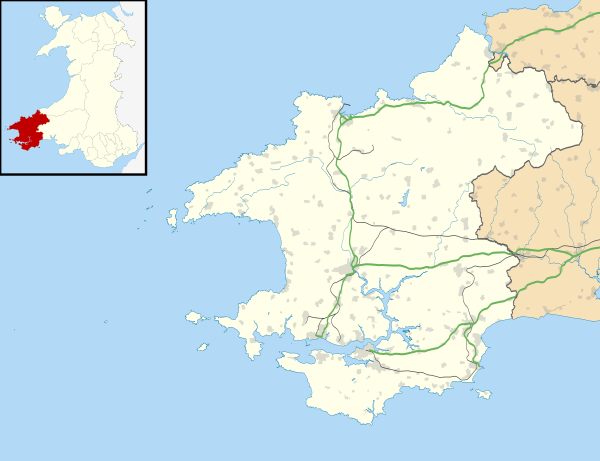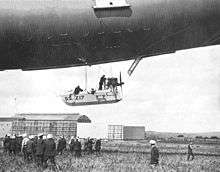RAF Carew Cheriton
| RAF Carew Cheriton | |||||||||||
|---|---|---|---|---|---|---|---|---|---|---|---|
| Carew, Pembrokeshire in Wales | |||||||||||
 RAF Carew Cheriton Shown within Pembrokeshire | |||||||||||
| Coordinates | 51°41′23″N 004°48′39″W / 51.68972°N 4.81083°WCoordinates: 51°41′23″N 004°48′39″W / 51.68972°N 4.81083°W | ||||||||||
| Type | Royal Air Force station | ||||||||||
| Site information | |||||||||||
| Owner | Air Ministry | ||||||||||
| Operator | Royal Air Force | ||||||||||
| Site history | |||||||||||
| Built | 1938 | ||||||||||
| In use | 1938-1945 | ||||||||||
| Airfield information | |||||||||||
| Elevation | 28 metres (92 ft) AMSL | ||||||||||
| |||||||||||
RAF Carew Cheriton is a former Royal Air Force airfield of Coastal and Training Command near Carew, Pembrokeshire. It was sited 4.7 miles (7.6 km) miles north west of Tenby. It was built on the site of RNAS Pembroke (aka RNAS Milton) from the First World War, which had been decommissioned and sold off in the inter war years.
History
First World War
Royal Naval Air Station Pembroke or Milton as it was known then opened in August 1915. The base operated SS-class (Submarine Scout or Sea Scout), SSZ-class (Sea Scout Zero) and C-class (Coastal-class or 'Coastals') non-rigid airships which operated over the Irish Sea, Bristol Channel and Western Approaches on anti-submarine patrols. In April 1917 the base began operating Sopwith 1½ Strutter and Airco D.H.6 biplanes.
Upon the formation of the Royal Air Force (RAF) on 1 April 1918, the Royal Naval Air Service (RNAS) ceased to exist. The location acquired the dual designation of RAF Pembroke[1][2] and Royal Naval Airship Station Pembroke. Use of the designation "RN Airship Station" was entirely valid, because the airships remained the property of the Admiralty, never being transferred to the Air Ministry.[3]
RAF Pembroke was part of No.14 Group, RAF, successor to the RNAS "Milford Haven Anti-Submarine Group". No.14 Group included No.255 Squadron, RAF. The entire site closed in March 1920.


Second World War
Carew Cheriton was recommissioned in 1938, initially with grass runways. From the early 1940s there were three concrete runways, making the station a Class A airfield. The airfield was used as a support station for the flying boat operations at RAF Pembroke Dock. Operational flying ceased in 1942. On 15 April 1941 12 airmen were killed in a Luftwaffe air raid which hit the station's sickbay. In 1942 the station became No. 10 Radio School, a training camp for aircrew wireless operators. RAF Carew Cheriton closed in 1945.
Based squadrons
| Squadron | Aircraft | From | To | To | Notes |
|---|---|---|---|---|---|
| 32 | Hawker Hurricane I | 17 April 1941 | 1 June 1941 | RAF Angle | Detachment from RAF Pembrey.[4] |
| 48 | Bristol Beaufort I | 16 July 1940 | 3 August 1941 | RAF Stornoway | Detachment from RAF Hooton Park.[5] |
| 75 | Vickers Wellington I | 14 September 1939 | 8 April 1940 | Disbanded | Detachment from RAF Harwell.[6] |
| 217 | Avro Anson I Bristol Beaufort I | 2 October 1939 | 29 October 1941 | RAF Thorney Island | Detachment from RAF St Eval.[7] |
| 236 | Bristol Blenheim IVF Bristol Beaufighter IC | 21 March 1941 | 9 February 1942 | RAF Wattisham | A detachment was at RAF St Eval.[8] |
| 238 | Hawker Hurricane IIA | 1 April 1941 | 16 April 1941 | RAF Chilbolton | Detachment from RAF Pembrey.[9] |
| 254 | Bristol Blenheim IVF | 11 February 1942 | 1 June 1942 | RAF Dyce | [10] |
| 286 | Hawker Hurricane IIC | April 1942 | April 1944 | RAF Zeals | Detachment from RAF Lulsgate Bottom.[11] |
| 320 | Lockheed Hudson I | 18 January 1941 | 21 March 1941 | RAF Leuchars | Absorbed 321 Squadron.[12] |
| 321 | Avro Anson I | 24 June 1940 | 18 January 1941 | RAF Carew Cheriton | Absorbed by 320 Squadron.[12] |
| 500 | Bristol Blenheim IV | 30 May 1941 | 22 March 1942 | RAF Stornoway | Detachment from RAF Bircham Newton.[13] |
| 587 | Hawker Henley I Hawker Hurricane IV Miles Martinet Hawker Hurricane IIC | 10 April 1944 | 1 October 1944 | RAF Weston Zoyland | Detachment from RAF Culmhead.[14] |
Postwar
The base was used as an emergency landing site on two occasions after its closure. A de Havilland Vampire FB.5 from Anglesey made a successful emergency landing on the old runway after experiencing mechanical problems. A Bristol Beaufighter in a separate incident also attempted an emergency landing but sadly crashed short of the runway with no survivors.
Current use
The site is no longer used as an airfield though much remains including the runway and the Second World War control tower (adjacent to the Carew Cheriton Showground) has been restored by the Carew Cheriton Control Tower Group, and turned into a museum which is open to the public. The airfield is also used for various events and activities including car boot sales, auctions and part of the airfield has been converted for use as a go-cart track.
Other Information
In 1962 Airfix released a 1/72 scale plastic model kit of Avro Anson Mk.I RAF serial: N9742, squadron code: MW-Y of No.321 (Dutch) Squadron RAF which was stationed at RAF Carew Cheriton August–November 1940. It has been rereleased several times since.
References
Citations
- ↑ Bones Aviation Page, "UK Airfields Macmerry to Syerston" downloaded 09 June 2014.
- ↑ Dyfed Archeological Trust. "Twentieth Century Military Sites: Airfields. A threat-related assessment 2011-2012, p.29.
- ↑ Turpin, B. British Naval Airships 1909-1921, to be published 2015. Pers Corr with the author.
- ↑ Jefford 1988, p. 35.
- ↑ Jefford 1988, p. 41.
- ↑ Jefford 1988, p. 48.
- ↑ Jefford 1988, p. 71.
- ↑ Jefford 1988, p. 75.
- ↑ Jefford 1988, p. 76.
- ↑ Jefford 1988, p. 79.
- ↑ Jefford 1988, p. 84.
- 1 2 Jefford 1988, p. 86.
- ↑ Jefford 1988, p. 94.
- ↑ Jefford 1988, p. 97.
Bibliography
- Jefford, C.G, MBE,BA ,RAF (Retd). RAF Squadrons, a Comprehensive Record of the Movement and Equipment of all RAF Squadrons and their Antecedents since 1912. Shrewsbury, Shropshire, UK: Airlife Publishing, 1988. ISBN 1-84037-141-2.
External links
| Wikimedia Commons has media related to RAF Carew Cheriton. |
